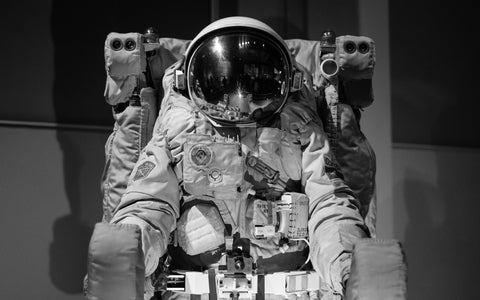With the space community’s focus being Martian exploration, there has been a lot of talk surrounding space suit technology and how it should eventually evolve. NASA has come a long way from the silvery spacesuits of the past, but hasn’t seen much change since the white boxy suits of the 1980’s. To get humans back to the moon and all the way to Mars, there are several design and functionality issues to address, the result being a much more advanced suit both technologically and aesthetically.
The first spacesuits were introduced in the 1960’s and were variations of flight suits used by the US Navy. The spacesuits eventually worn by the Apollo mission were the first to address the need for astronauts to exist for an extended period of time outside of their spacecraft. They had to be able to withstand the dust and sharp glass of the moon’s surface, regulate temperature, and be flexible enough to pick up moon rocks and other samples. These spacesuits weighed about 180 pounds.
The current technology was introduced in 1983 during the space shuttle era. These suits are referred to as Extravehicular Mobility Units; EMUs. They can also be equipped with a MMU (Mobile Maneuvering Unit) which is essentially a jet pack that allows astronauts to move through the vacuum of space untethered to the International Space Station. EMUs are a 14-layer gas pressurized suit which allows the astronaut’s liquid blood to circulate. Fully loaded, these suits can weigh up to 320 lbs. 11 of the original 18 EMUs still exist, several of them aboard the ISS.
The EMUs, while they have served their purpose, are not without their flaws. For example, recently the scheduled all-women crewmember space walk had to be canceled because they were unable to fit two spacesuits to the size of two female astronauts. Both female astronauts require a medium sized torso piece which, while it can be done, will take time. The space suits also lack mobility needed in the gloves for Mars and lunar explorations in order to collect samples and operate machinery. Additionally, the weight of the spacesuit should not exhaust the wearer during an exploratory mission as they would today.
In order to address these problems, NASA engineers and private organizations have been researching and developing prototype suits with Lunar and Martian exploration in mind. The new NASA Z-2 suit will be a high-pressure suit with metal bands in the knuckles and palms to increase dexterity. The sizing inserts of the suit will also be more easily interchangeable to permit resizing in orbit. The suit’s hard exterior is also built to withstand dust and debris of Martian and Lunar surfaces. “It’s really the world’s smallest spacecraft” says MIT Aerospace Engineer, Dave Newman. It must take all the functions of a spacecraft and miniaturize them around a person. “We don’t want you to fight the suit,” says Newman, “we want you to find life on Mars.”
Though there is still much more research and development to be done, engineers plan to display a mockup suit in museum exhibits this year and have a functional prototype ready for testing by 2020. By partnering with private companies like Space-X, Boeing, and Lockheed Martin, NASA hopes to drive down the cost and increase the innovation of the new suit.






